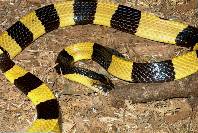Facts About Bungarus
Kraits, belonging to the genus Bungarus, are venomous snakes native to South and Southeast Asia. There are 15 distinct species of these snakes, ranging across tropical regions from Iran to the Indian subcontinent and further into Southeast Asia. Kraits typically measure between 1 and 2 meters in length and are recognized for their smooth, glossy scales decorated with striking striped patterns.
These snakes are nocturnal hunters, primarily preying on other snakes (including venomous ones), as well as mice and small lizards. Kraits are oviparous, which means they lay eggs, typically in leaf litter.
One of the most remarkable features of kraits is their extremely potent neurotoxic venom, making them some of the most dangerous terrestrial snakes in the world. Their venom functions by inducing muscle paralysis through presynaptic neurotoxins. Although krait bites are rare due to their nocturnal behavior, they can be fatal and require immediate medical attention. Symptoms of a krait bite include severe abdominal cramps, muscle paralysis, and respiratory failure.
Treatment for krait bites involves the administration of antivenom and supportive care until the venom is metabolized by the body. The mortality rate varies among different krait species, with the common krait being particularly deadly if left untreated. Fortunately, polyvalent elapid antivenom is effective against the venom of several Bungarus species.

 India
India